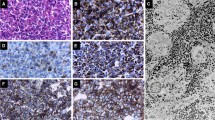Summary
Surgical specimens of 15 normal and 106 para-adenomous anterior pituitaries were studied immunocytochemically and in part electron microscopically for the presence of hyperplasia. GH cell hyperplasia was found in 13% of all normal pituitaries, in 6% of the cases with Prolactin secreting adenomas and in 9% of the cases with ACTH secreting adenomas. Prolactin cell hyperplasia occured in nearly equal percentages (17–23%) in normal pituitaries and in areas adjacent to GH-, Prolactin-or ACTH-secreting adenomas or adjacent to inactive adenomas. Previous findings of relatively more frequent Prolactin cell hyperplasia occuring together with Prolactin producing adenomas have to be revised. Prolactin cell hyperplasia as a primary source of hyperprolactinemia is very rare and almost always occurs in conjunction with oncocytic adenomas. ACTH cell hyperplasia was found in 13% of the normal pituitaries, in 14% of the cases with Prolactin secreting adenomas, in 58% of the cases with ACTH producing adenomas and in 40% of the pituitaries with GH secreting adenomas. We have no explanation for the latter result. ACTH cell hyperplasia may be the primary cause of Cushing's disease (18% of all Cushing cases). Hyperplasia of TSH cells in normal pituitaries was rare (7%) and with the exception of Prolactin producing adenomas (22%) was not found near adenomas. Clinical-pathological correlations are discussed.
Similar content being viewed by others
References
Adams CWM, Swettenham KV (1958) The histochemical identification of two types of basophil cell in the normal human adenohypophysis. J Pathol Bacteriol 75:95–103
Bigos ST, Somma M, Rasio E, Eastman RC, Lanthier A, Johnston HH, Hardy J (1980) Cushing's disease. Management by transsphenoidal pituitary microsurgery. Clin Endocrin Metab 2:348–354
Carmalt MHB, Dalton GA, Fletcher RF, Smith WT (1977) The treatment of Cushing's disease by transsphenoidal hypophysectomy. Quart J Med 46:119–134
Fowler MR, McKeel DW (1979) Human adenohypophyseal quantitative histochemical cell classification. 1. Morphologic criteria and cell type distribution. Arch Pathol 103:613–620
Girod C, Mazzuca M, Trouillas J, Tramu G, Lhéritier M, Beauvillain J-C, Claustrat B, Dubois M-P (1980) Light microscopy, fine structure and immunochemistry studies of 278 pituitary adenomas. In: Bricaire H, Guiot G, Racadot J (eds) Pituitary adenomas. Biology, physiopathology and treatment. Asclepios, Paris, pp 3–18
Kovacs K, Horvath E, Ryan N (1981) Immunocytochemistry of the human pituitary. In: De Lellis RA (ed) Diagnostic immunohistochemistry. Masson, New York Paris Barcelona Milan Mexico City Rio de Janeiro, pp 17–35
Lamberts SWJ, Stefankao St Z, de Lange SA, Fermin H, van der Vijver J-C M, Weber RFA, de Jong FH (1980) Failure of clinical remission after transsphenoidal removal of a microadenoma in a patient with Cushing's disease. Multiple hyperplastic and adenomatous cell nests in surrounding pituitary tissue. Clin Endocrinol Metab 4:793–795
Lüdecke DK, Bansemer J, Resetic J, Westphal M (1980) Different corticoid feedback effects in adenomatous and anterior lobe tissue in Cushing's disease. In: Faglia G, Giovanelli MA, MacLeod RM (eds) Pituitary microadenomas. Proc Serono Symposia 29, Academic Press, London, pp 187–194
Lüdecke DK, Kautzky R, Bansemer J, Resetic J, Montz HR (1978) ACTH secretion and neurosurgical management of Cushing's disease. In: Fahlbusch R, Werder K v (eds) Treatment of pituitary adenomas. First European Workshop at Rottach-Egern, Thieme, Stuttgart, pp 333–339
Lüdecke DK, Kautzky R, Saeger W, Schrader D (1976) Selective removal of hypersecreting pituitary adenomas? An analysis of endocrine function, operative and microscopical findings of 101 cases. Acta Neurochir (Wien) 35:27–42
Lüdecke DK, Müchler HC, Caselitz J, Saeger W (1981) ACTH and cortisol patterns after selective adenomectomy in Cushing's disease. Acta Endocrinol (Kbh) 240:61–62
Saeger W (1974) Zur Ultrastruktur der hyperplastischen und adenomatösen ACTH-Zellen beim Cushing-Syndrom hypothalamisch hypophysärer Genese. Virchows Arch A [Pathol Anat] 362:73–88
Saeger W (1977a) Die Hypophysentumoren. Cytologische und ultrastrukturelle Klassifikation, Pathogenese, endokrine Funktionen und Tierexperiment. In: Büngeler W, Eder M, Lennert K, Peters G, Sandritter W, Seifert G (eds) Veröffentlichungen aus der Pathologie. Fischer, Stuttgart 107:1–240
Saeger W (1977b) Die Morphologie der paraadenomatösen Adenohypophyse. Ein Beitrag zur Pathogenese der Hypophysenadenome. Virchows Arch [Pathol Anat] 372:299–314
Saeger W (1978) Morphology of ACTH-producing pituitary tumors. In: Fahlbusch R, Werder K v (eds) Treatment of pituitary adenomas. First European Workshop at Rottach-Egern. Thieme, Stuttgart, pp 122–130
Saeger W (1981) Hypophyse. In: Doerr W, Seifert G, Uehlinger E (Hrsg) Spezielle pathologische Anatomie. Ein Lehrbuch und Nachschlagewerk. Band XIV Endokrine Organe. Springer, Berlin Heidelberg New York, 1:1–226
Sternberger LA, Hardy PH, Cuculis JJ, Meyer HG (1970) The unlabled antibody enzyme method of immunohistochemistry. J Histochem Cytochem 18:315–333
Trouillas J, Cure M, Lhéritier M, Girod C, Pallo D, Tourniaire J (1976) Les adenomes hypophysaires avec amenorrhee-galactorrhee ou galactorrhee isolee. De la cellule á prolactine normale á la cellule á prolactine adenomateuse, étude microscopique photonique et ultrastructurale avec correlations anatomo-cliniques dans 11 observations personelles. Lyon Medical 236:359–375
Tyrell JB, Brooks RM, Fitzgerald PA, Cofoid PB, Forsham PH, Wilson CB (1978) Cushing's disease. Selective trans-sphenoidal resection of pituitary microadenomas. N Engl J Med 298:753
Author information
Authors and Affiliations
Additional information
Supported by the Sonderforschungsbereich 34 (Endocrinology) of the Deutsche Forschungs-gemeinschaft
Rights and permissions
About this article
Cite this article
Saeger, W., Lüdecke, D.K. Pituitary hyperplasia. Vichows Archiv A Pathol Anat 399, 277–287 (1983). https://doi.org/10.1007/BF00612945
Accepted:
Issue Date:
DOI: https://doi.org/10.1007/BF00612945




